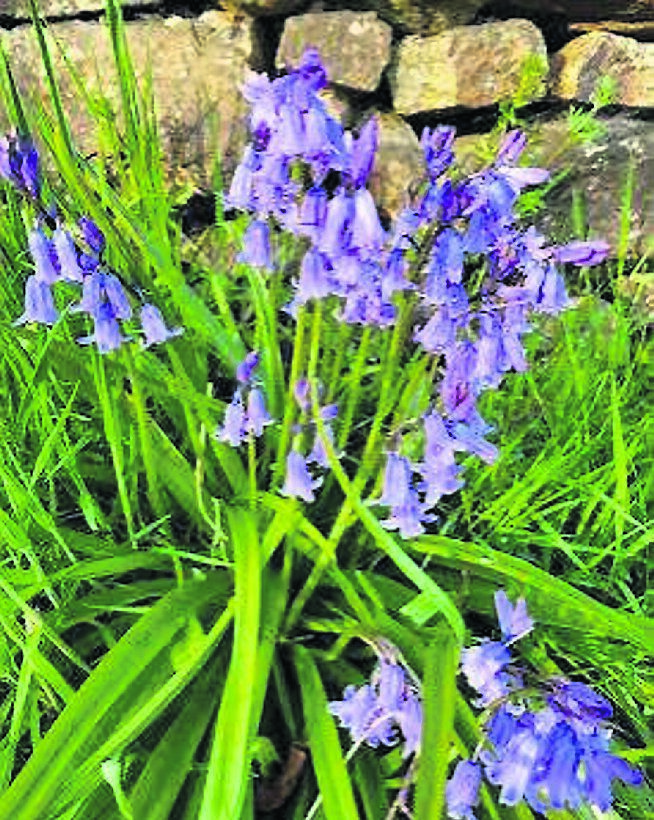In the Garden: It’s showtime for the tulips and bluebells

Tulip ‘Mango Charm’ looking good in beds and borders now. See below, details of Plant of the Week.
IT’S a busy time of the year in the garden as the season gets going. There is still a window for moving and dividing herbaceous perennials as they emerge from their slumber.
Now is a great time to propagate from basal cuttings as the new growth is full of vigour and many will root readily. It is a great way to multiply favourite plants to increase stock for elsewhere in the garden, or to gift to friends.
Last chance now to get hedging and trees planted before the buds burst into leaf. One of the few benefits of the wet spring is that it is settling newly planted trees, shrubs and perennials well into their new positions.
There is no shortage of water at their roots, and this will help them to establish a good rooting system as quickly as possible.
It has been a slow spring in the garden but the colour is gradually building. If you have acidic soil then no doubt rhododendrons and azaleas are starting to take centre stage. These are great spring flowering stalwarts.
Some great gardens to visit for displays en masse of these beauties include Mount Congreve near Waterford city, Kilmacurragh in Co. Wicklow, and closer to home, Annesgrove, near Castletownroche, and Blarney Castle and Gardens. The time comes around again so quickly for garden visiting and getting inspiration.

Large drifts of bluebells and wild garlic in woodland settings are pretty special at this time of year as the plants prepare for the canopy to close in when the trees come into leaf. The race is on to flower while the light is available!
For many other plants, growth is just beginning as seeds are being sown at a pace now. Temperatures have started to improve and so germination will happen more quickly.
Do be careful of low night-time temperatures at this time of year as we can get frosts into May and these will do serious damage to young plants.
Some direct sowing can be done outdoors now of the hardier vegetables - try some beetroot, carrot and lettuce to get some early harvests.
It has been a tricky time preparing soil for vegetable growing in the garden. The no-dig method certainly comes into its own during wet weather. Keeping digging to a minimum ensures that there is less disturbance to soil microbes, fungi and bacteria beneath the surface of the soil.
Mulching the surface of the soil with an organic medium which will feed soil microbes essentially feeds the soil and not just the plant. It is a more holistic approach to growing.

A broad fork is a popular tool used to aerate and loosen up the top surface of the soil after the winter months.
The soil is much more vulnerable to damage when it is full of water, and it is really important to keep any work to a minimum until it dries out.
This year, there was no opportunity to pull up the rye grass and phacelia green manure that was covering the vegetable beds for the winter months.
Usually, about one month is needed for the crop to decompose enough in situ before a crop is planted into the soil. As it was so late removing the green manure, it was removed from the surface of the soil and returned to the compost heap. This does require more movement of materials but nothing is wasted and the green manure will make some delicious compost for use next year from the heap!
Homemade compost which had been decomposing for more than a year was then spread on the surface of the bed in preparation for planting a crop.
A few perennial weeds had emerged among the green manure over winter, like dandelion and dock root, and these were also dug out as they would compete with the crop to be planted.
It is so convenient to purchase young vegetable plants in modules that are ready to be planted out. Growing from seed does allow more control over the varieties chosen, and we all have preferred varieties for flavour, taste and perhaps sometimes nostalgia.
There will be plenty of plant fairs happening from now on, with Fota Plant Fair happening this weekend on April 21 after postponement last week.
The Clare Garden Festival takes place in Ennis showgrounds on Sunday, April 28, and these plant fairs are a great place to purchase trees, shrubs, perennials and also young vegetable plants to get the kitchen garden going this year.
Plant of the Week
Tulips are giving it their all right now and there are some great colours appearing. Experimenting with different varieties each year provides something to look forward to and assess.
Different aspects are to be considered. If it suits the planting situation, if the colour combination works, and if the timing of flowering is what is required.
Tulips come in a range of heights, from 10cm to 60cm, taller tulips generally look better in beds and borders, and the more compact varieties are better suited to container planting.
Tulip varieties generally begin flowering in February or March and keep going right into May.
Layering tulips in pots can provide months of colour if the right varieties are chosen. The Tulip ‘Mango Charm’ is a beautiful soft, peachy pink colour with a flush of yellow and is flowering now. It is a taller one, getting to about 50cm, so better for beds and borders.
Planting tulips in the dark days before Christmas is an undertaking that brings much pleasure in spring.







 App?
App?


